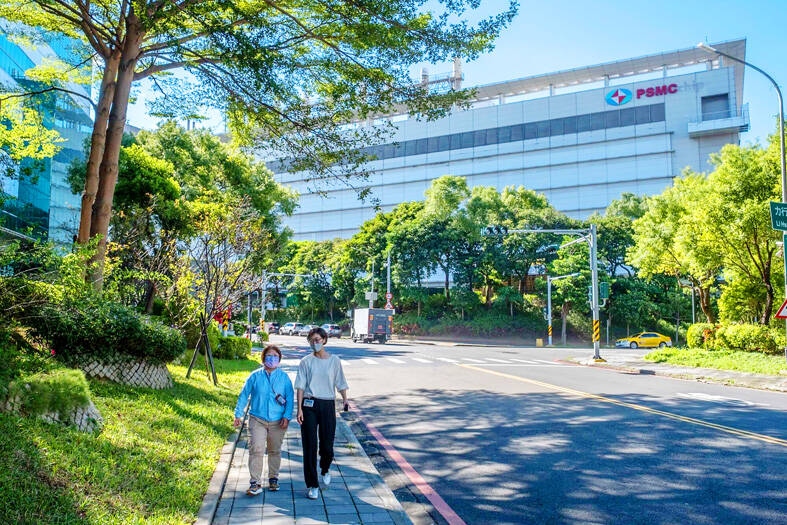Powerchip Semiconductor Manufacturing Corp (力積電), which manufactures DRAM chips and driver ICs on a contract basis, yesterday said it could continue to post operating losses in the second half of the year, as cautious consumer spending casts a cloud over business prospects.
Powerchip slipped into the red last quarter, reporting an operating loss of NT$66 million (US$2.12 million) versus an operating profit of NT$334 million in the first quarter. It was the first operating loss reported by the chipmaker since its return to the local equity market in 2019.
However, thanks to foreign-exchange-related gains, Powerchip posted a net profit of NT$617 million, compared with NT$187 million in the first quarter. That translated into earnings per share of NT$0.15, up from NT$0.05 in the first quarter.

Photo: Lam Yik Fei, Bloomberg
The Hsinchu-based chipmaker said its businesses have stabilized as customers’ inventory digestion nears an end, but it has yet to see clear signs of a recovery.
The company aims to minimize its operating losses this quarter by shutting down some underutilized manufacturing equipment to save on costs, Powerchip president Brian Shieh (謝再居) told an online investors’ conference.
“We believe such cost-saving measures would help offset the downtrend in average selling prices and help us keep operating losses within a small range,” Shieh said.
Overall, factory utilization is to remain at about 60 percent this quarter, as chip demand remains fragile, Shieh said.
The chipmaker said it has received short-term demand to rebuild inventories for display driver ICs and CMOS image sensors, but it needs more long-term orders to support its quarterly revenue.
In addition, demand for power management and radio-frequency chips used in vehicles and industrial devices appears weak, as customers are not as keen to secure chip supply as they were before, Powerchip said.
As a result, Powerchip expects its “operations in the third quarter would be little changed from that of the second quarter,” Shieh told investors.
Consumers in the US and Europe are conservative about spending on consumer electronics due to high inflationary pressures, Shieh said.
In China, its economic outlook looks gloomy in the short term as the much-anticipated revenge spending did not occur after China emerged from the COVID-19 pandemic, he said.
“It is difficult for us to expect a quick improvement in market sentiment. We are conservative about the third-quarter outlook,” Shieh said.
Revenue this quarter is likely to drop by a single-digit percentage from the second quarter’s NT$11 billion, Shieh said.
Gross margin is expected to shrink 1 to 2 percentage points in the third and fourth quarters from 16.8 percent last quarter, the chipmaker said.
The DRAM chip segment is a bright spot, Powerchip said.
The company said it has been receiving more inquiries about DRAM chips from Chinese customers following US curbs on chip exports.
Powerchip yesterday revised up its capital spending to US$1.93 billion for this year from its previous estimate of US$1.89 billion, mostly to fund the construction of a new 12-inch fab in Miaoli County’s Tongluo Science Park (銅鑼科學園區).
Commenting on potential capacity expansion in Japan together with SBI Holdings Inc, the chipmaker said its Japanese partner would be in charge of funding, while Powerchip would provide technology support.

Shiina Ito has had fewer Chinese customers at her Tokyo jewelry shop since Beijing issued a travel warning in the wake of a diplomatic spat, but she said she was not concerned. A souring of Tokyo-Beijing relations this month, following remarks by Japanese Prime Minister Sanae Takaichi about Taiwan, has fueled concerns about the impact on the ritzy boutiques, noodle joints and hotels where holidaymakers spend their cash. However, businesses in Tokyo largely shrugged off any anxiety. “Since there are fewer Chinese customers, it’s become a bit easier for Japanese shoppers to visit, so our sales haven’t really dropped,” Ito

The number of Taiwanese working in the US rose to a record high of 137,000 last year, driven largely by Taiwan Semiconductor Manufacturing Co’s (TSMC, 台積電) rapid overseas expansion, according to government data released yesterday. A total of 666,000 Taiwanese nationals were employed abroad last year, an increase of 45,000 from 2023 and the highest level since the COVID-19 pandemic, data from the Directorate-General of Budget, Accounting and Statistics (DGBAS) showed. Overseas employment had steadily increased between 2009 and 2019, peaking at 739,000, before plunging to 319,000 in 2021 amid US-China trade tensions, global supply chain shifts, reshoring by Taiwanese companies and

Taiwan Semiconductor Manufacturing Co (TSMC) Chairman C.C. Wei (魏哲家) and the company’s former chairman, Mark Liu (劉德音), both received the Robert N. Noyce Award -- the semiconductor industry’s highest honor -- in San Jose, California, on Thursday (local time). Speaking at the award event, Liu, who retired last year, expressed gratitude to his wife, his dissertation advisor at the University of California, Berkeley, his supervisors at AT&T Bell Laboratories -- where he worked on optical fiber communication systems before joining TSMC, TSMC partners, and industry colleagues. Liu said that working alongside TSMC

TECHNOLOGY DAY: The Taiwanese firm is also setting up a joint venture with Alphabet Inc on robots and plans to establish a firm in Japan to produce Model A EVs Manufacturing giant Hon Hai Precision Industry Co (鴻海精密) yesterday announced a collaboration with ChatGPT developer OpenAI to build next-generation artificial intelligence (AI) infrastructure and strengthen its local supply chain in the US to accelerate the deployment of advanced AI systems. Building such an infrastructure in the US is crucial for strengthening local supply chains and supporting the US in maintaining its leading position in the AI domain, Hon Hai said in a statement. Through the collaboration, OpenAI would share its insights into emerging hardware needs in the AI industry with Hon Hai to support the company’s design and development work, as well